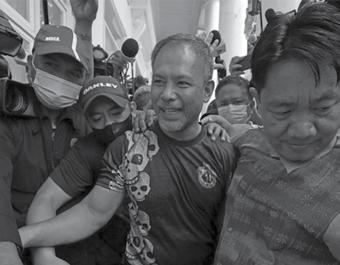
3 minute read
DOJ indicts Bantag, several...
PAGE 8 participation,” are: as principal inducement.
Others indicted for the inmate’s murder, “as principal by direct
Advertisement
PDL Maria Alvarez
PDL Joseph Georfo
PDL Christian Ramac
PDL Ricky Salgado
PDL Ronnie Dela Cryz
PDL Joel Reyes
“Accordingly, the Panel of Prosecutors respectfully recommends the approval of the two corresponding Informations (charge sheets) in the above-entitled case,” part of the resolution read.
The murder charges will be filed before the courts of Las Piñas and Muntinlupa, over the separate incidents of the killing of Lapid and Villamor, respectively.

Bantag meanwhile is also facing criminal raps for alleged torture of Bilibid inmates, and graft and plunder complaints. n sensing danger where it doesn’t exist, said James Garbarino, an emeritus professor of psychology at Cornell University and Loyola University-Chicago. Kids who live with constant fear are more likely to look to firearms or gangs for protection. They can be triggered to take preemptive action — such as firing a gun without thinking — against a perceived threat.
“Their bodies are constantly ready for a fight,” said Gianna Tran, deputy executive director of the East Bay Asian Youth Center in Oakland, California, which works with young people living in poverty, trauma, and neglect.
Unlike mass shooters, who buy guns and ammunition because they’re intent on murder, most teen violence is not premeditated, Garbarino said.
In surveys, most young people who carry guns — including gang members — say they do so out of fear or to deter attacks, rather than perpetrate them. But fear of community violence, both from rivals and the police, can stoke an urban arms race, in which kids feel that only the foolish walk around without a weapon.
“Fundamentally, violence is a contagious disease,” said Dr. Gary Slutkin, founder of Cure Violence Global, which works to prevent community violence.
Although a small number of teens become hardened and remorseless, Pratt said, he sees far more shootings caused by “poor conflict resolution” and teenage impulsivity rather than a desire to kill.
Indeed, firearms and an immature teenage brain are a dangerous mix, Garbarino said. Alcohol and drugs can magnify the risk. When confronted with a potentially life-or-death situation, kids may act without thinking.
When Diego was 16, he was walking a girl to school and they were approached by three boys, including a gang member who, using obscene and threatening language, asked if Diego was also in a gang. Diego said he tried to walk past the boys, one of whom appeared to have a gun.
“I didn’t know how to fire a gun,” Diego said. “I just wanted them to get away.”
In news accounts of the shooting, witnesses said they heard five gunshots. “The only thing I remember is the sound of the shots,” Diego said. “Everything else was going in slow motion.”
Diego had shot two of the boys in the legs. The girl ran one way, and he ran another. Police arrested Diego at home a few hours later. He was tried as an adult, convicted of two counts of attempted homicide, and sentenced to 12 years.
A Second Chance
In the past two decades, the justice system has made major changes in the way it treats children.
Youth arrests for violent crime plummeted 67% from 2006 to 2020, and 40 states have made it harder to charge minors as adults. States also are adopting alternatives to incarceration, such as group homes that allow teens to remain in their communities, while providing treatment to help them change their behavior.
Because Diego was 17 when he was sentenced, he was sent to a juvenile facility, where he received therapy for the first time.
Diego finished high school while behind bars and went on to earn an associate’s degree from a community college. He and other young inmates went on field trips to theaters and the aquarium — places he had never been. The detention center director asked Diego to accompany her to events about juvenile justice reform, where he was invited to tell his story.
Those were eye-opening experiences for Diego, who realized he had seen very little of Chicago, even though he had spent his life there.
“Growing up, the only thing you see is your community,” said Diego, who was released after four years in detention, when the governor commuted his sentence. “You assume that is what the whole world is like.”
KHN data editor Holly K. Hacker and researcher Megan Kalata contributed to this report.
KHN (Kaiser Health News) is a national newsroom that produces in-depth journalism about health issues. Together with Policy Analysis and Polling, KHN is one of the three major operating programs at KFF (Kaiser Family Foundation).
KFF is an endowed nonprofit organization providing information on health issues to the nation.



